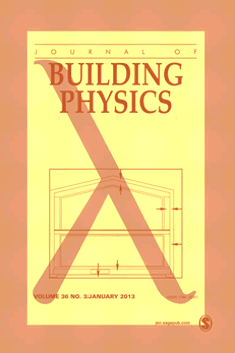
Journal of Building Physics
Scope & Guideline
Advancing the Science of Sustainable Structures
Introduction
Aims and Scopes
- Energy Efficiency in Buildings:
The journal emphasizes research aimed at improving energy efficiency in building designs, including studies on insulation materials, thermal performance, and renewable energy integration. - Hygrothermal Behavior of Building Materials:
A core focus is on the hygrothermal performance of various building materials, investigating moisture transfer, thermal dynamics, and the impact of climate conditions on material behavior. - Indoor Air Quality and Comfort:
Research addressing the indoor environmental quality, including air flow, thermal comfort, and the effects of building design on occupant health and well-being, is a significant part of the journal's scope. - Sustainable Building Practices:
The journal promotes the exploration of sustainable building practices, evaluating eco-friendly materials, green roofs, and passive design strategies that contribute to reduced environmental impact. - Computational and Experimental Modeling:
The use of computational methods, such as CFD simulations and machine learning, alongside experimental validation, is a hallmark of the research published, facilitating the design and optimization of building systems.
Trending and Emerging
- Smart Building Technologies:
The integration of smart technologies and IoT (Internet of Things) in building design and operation is gaining traction, emphasizing real-time monitoring and adaptive systems for energy management. - Climate-Responsive Design:
Research focusing on climate-responsive building design is on the rise, exploring how structures can adapt to varying environmental conditions to enhance energy efficiency and occupant comfort. - Bio-based and Recycled Materials:
An increasing number of studies are investigating the use of bio-based and recycled building materials, aligning with sustainability goals and the circular economy. - Machine Learning and Data-Driven Approaches:
The application of machine learning and data-driven methodologies for predicting building performance and optimizing designs is becoming prevalent, reflecting advancements in computational capabilities. - Multi-Objective Optimization Techniques:
Research utilizing multi-objective optimization techniques to balance energy efficiency, cost, and comfort in building designs is trending, highlighting the complexity of modern building systems.
Declining or Waning
- Traditional Construction Materials:
Research focused solely on traditional construction materials without considering innovative alternatives or sustainable practices has decreased, as the field trends towards more eco-friendly materials. - Basic Thermal Properties without Contextual Analysis:
Studies that only present basic thermal properties of materials without contextual analysis related to building performance or environmental conditions are less frequently published. - Historical Building Performance Analysis:
The analysis of historical building performance, while still relevant, has seen a decline as the journal increasingly features studies on modern building technologies and sustainability practices. - Single-Factor Studies:
Research that examines single factors in isolation, such as temperature or moisture without integrating multiple variables or a holistic approach, is becoming less common, reflecting a trend toward more complex, multifaceted investigations. - Low-Tech Solutions:
The focus on low-tech, non-innovative solutions for building physics challenges is waning, as there is a growing interest in high-tech, integrated systems that leverage advanced technology for performance improvements.
Similar Journals

International Journal of Ventilation
Elevating Standards in Ventilation ResearchThe International Journal of Ventilation, published by Taylor & Francis Ltd, serves as a critical platform for the dissemination of innovative research in the fields of building and construction, civil and structural engineering, control and systems engineering, and electrical and electronic engineering. With an ISSN of 1473-3315 and an e-ISSN of 2044-4044, this esteemed journal has maintained a significant presence since its inception in 2005 and continues to provide valuable insights for academics and professionals alike until 2024. Recognized in the 2023 rankings, it holds a Q2 designation in Building and Construction and Q3 status in several other engineering categories, reflecting its solid standing in the academic community. Despite its non-open access format, the journal remains a vital resource, focusing on advanced ventilation solutions that shape sustainable practices in building design and engineering systems. By publishing high-quality peer-reviewed articles, the International Journal of Ventilation plays a pivotal role in advancing knowledge, fostering collaboration, and inspiring future research within its dynamic fields of study.
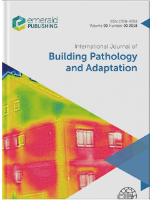
International Journal of Building Pathology and Adaptation
Unveiling new dimensions in building resilience.International Journal of Building Pathology and Adaptation is a premier publication dedicated to advancing knowledge in the field of building pathology and adaptation. Established by the esteemed Emerald Group Publishing Ltd, this journal serves as a vital platform for researchers and practitioners focusing on the assessment, preservation, and innovative adaptation of built environments. With an impressive Q2 ranking in both Building and Construction and Civil and Structural Engineering, and a Scopus ranking of #62 out of 223 in the relevant engineering disciplines, the journal showcases high-quality research with significant practical implications. Although currently not featuring an open-access model, its access options cater to a wide audience aiming to explore cutting-edge studies from 2017 to 2024. The journal's commitment to bridging the gap between academic inquiry and real-world application makes it an essential resource for anyone dedicated to advancing the resilience and sustainability of the built environment.

Archives of Thermodynamics
Unveiling the Science of Heat and EnergyArchives of Thermodynamics is a reputable journal dedicated to the field of thermodynamics, published by the esteemed POLISH ACADEMY OF SCIENCES. With a robust history since its inception in 2003, this journal serves as a critical platform for disseminating high-quality research aimed at advancing knowledge and technology in thermodynamic systems and processes. Recognized for its contribution to the field, it holds a Q3 ranking in the Physics and Astronomy (miscellaneous) category as of 2023, with a respectable Scopus rank of #148 out of 243, placing it within the 39th percentile. Although it follows a traditional access model, the journal's commitment to scholarly excellence ensures that researchers, professionals, and students alike can benefit from its rich archives and ongoing discussions within the scientific community. Situated in Warsaw, Poland, the journal not only reflects a regional dedication to scientific progress, but also engages with global audiences interested in the evolving landscape of thermodynamic research.

Building Simulation
Elevating Standards in Building Simulation ExcellenceBuilding Simulation is a leading academic journal published by TSINGHUA UNIVERSITY PRESS, focusing on the critical intersection of building and construction and energy efficiency. With its ISSN 1996-3599 and E-ISSN 1996-8744, this journal stands out in the Q1 category for both Building and Construction and Energy (miscellaneous), as recognized in the latest 2023 category quartiles. It has established itself as an influential platform for disseminating innovative research and developments in building performance simulation and energy use optimization, boasting impressive Scopus rankings at Rank #15/223 in Engineering (Building and Construction) and Rank #15/78 in Energy (miscellaneous), placing it in the upper percentiles of its field. Since its inception in 2008, the journal has fostered a rich dialogue among practitioners, researchers, and students, empowering them to advance sustainable building practices and contribute to global energy conservation efforts. Building Simulation is an open-access journal, making its valuable content accessible to a worldwide audience, further enhancing its role as a vital resource in the quest for innovative building solutions.

Frontiers in Built Environment
Unlocking insights for sustainable urban development.Frontiers in Built Environment, published by FRONTIERS MEDIA SA, is a highly regarded open-access journal that has established itself as a significant platform for cutting-edge research in the fields of building and construction, geography, planning and development, and urban studies. Since its inception in 2015, this journal has embraced a commitment to disseminating high-quality, peer-reviewed research, allowing researchers, professionals, and students to access pivotal findings and insights without financial barriers. With an impressive 2023 impact factor, it ranks in the Q1 tier for Urban Studies and is positioned within the Q2 tier for both Building and Construction and Geography, Planning and Development, demonstrating its influence and relevance in evolving urban and environmental challenges. Its rigorous indexing, exemplified by a strong Scopus ranking, reflects its contribution to the advancement of knowledge in these critical areas. With a clear dedication to fostering innovation and collaboration within the built environment sector, Frontiers in Built Environment is essential reading for those engaged in shaping sustainable urban futures.

Architect
Bridging Theory and Practice in ArchitectureArchitect is a publication dedicated to the diverse and evolving field of architecture and design, presented by the reputable HANLEY WOOD, LLC. Since its inception in 1975, the journal has traversed critical periods in architecture, offering valuable insights and research that cater to both practitioners and academics alike. The journal holds a Q4 ranking in both Architecture and Visual Arts and Performing Arts, indicating its niche presence within the crowded scholarly landscape. Despite its recent rankings within the Scopus, where it lies in the lower percentiles of the architecture category, the Architect journal provides platforms for innovative discussions and explorations in design, helping to shape the discourse in the architectural community. While the journal is currently accessible via traditional subscription models, it remains a critical resource for those seeking to bridge practice and theory in architecture. As it continues to evolve beyond its historical publication periods, Architect aims to nurture a rich environment for professional growth, scholarship, and dialogue among researchers, designers, and students engaged in the dynamic world of architecture.
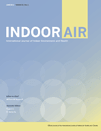
INDOOR AIR
Innovating Indoor Standards for Global Well-being.INDOOR AIR is a leading peer-reviewed journal published by WILEY-HINDAWI, focusing on the critical field of indoor environmental quality and its impact on public health. Since its inception in 1991, this esteemed journal has been at the forefront of research in Building and Construction, Environmental Engineering, and Public Health. With a commendable Q1 ranking across these categories in 2023, INDOOR AIR has established itself as a pivotal resource for scholars and industry professionals alike, as evidenced by its impressive Scopus rankings—35th in Public Health, 14th in Building and Construction, and 20th in Environmental Engineering. The journal is dedicated to disseminating groundbreaking research, reviews, and case studies that advance knowledge and methodologies in improving indoor air quality and its implications for health outcomes. Aspiring to maintain open access to vital scientific discourse, INDOOR AIR invites contributions that foster interdisciplinary collaboration and innovation in understanding indoor environments. Based in Denmark, the journal continues to engage a global audience committed to enhancing health and well-being through improved indoor air quality.
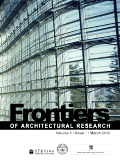
Frontiers of Architectural Research
Shaping the Future of Architecture Through Open ScholarshipFrontiers of Architectural Research, published by KEAI PUBLISHING LTD, stands at the forefront of interdisciplinary scholarship, addressing contemporary challenges in the fields of architecture, urban studies, building and construction, and archaeology. Since its establishment in 2012, this open-access journal has rapidly gained recognition, achieving prestigious rankings in the 2023 category quartiles, including Q1 placements in both Architecture and Archaeology. With an impressive Scopus rank of #5 out of 354 in Archaeology and #10 out of 189 in Engineering - Architecture, it demonstrates its significant influence and contribution to advancing architectural research. Frontiers of Architectural Research embraces a broad scope that fosters innovative discourse and practical solutions, catering to a diverse audience of researchers, professionals, and students keen on exploring the intersection of culture, environment, and technology. By ensuring immediate access to research findings, the journal not only enhances the visibility of scholarly work but also encourages collaborative dialogues that shape the future of architectural practice.
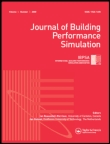
Journal of Building Performance Simulation
Exploring the Future of Architecture and Construction TechnologiesJournal of Building Performance Simulation, published by Taylor & Francis Ltd, is a premier academic journal dedicated to advancing the fields of architecture, building and construction, and computational modeling. With an ISSN of 1940-1493 and an E-ISSN of 1940-1507, this journal is recognized for its high-quality, peer-reviewed research, reflected in its impressive Q1 ranking in both Architecture and Building and Construction categories for 2023. Spread over a notable converged publishing timeline from 2008 to 2024, it aims to address contemporary issues in building performance and simulation methodologies, serving both practitioners and academics alike. Positioned within the 92nd percentile in Engineering - Architecture, the journal is a vital resource for professionals focused on innovative design and simulation technologies that enhance building efficiency and sustainability. Despite its robust reputation, the journal currently does not offer open-access options, which underscores its commitment to maintaining academic rigor. Engage with cutting-edge research that drives the future of building performance through this influential journal.

Building Services Engineering Research & Technology
Pioneering Research for a Sustainable Built EnvironmentBuilding Services Engineering Research & Technology is a leading journal published by SAGE Publications Ltd, dedicated to advancing the field of building services engineering. With an ISSN of 0143-6244 and an E-ISSN of 1477-0849, the journal has established itself as a vital resource since its inception in 1980, operating as an essential platform for disseminating high-quality research and technological innovations up to 2024. The journal is well-respected within the academic community, reflected in its Q2 category ranking in Building and Construction and a commendable 67th percentile rank among the 223 journals in its field, according to Scopus. Although it does not offer open access, it provides extensive insights and rigorous studies that are invaluable for researchers, practitioners, and students alike. As a central hub for the exploration of cutting-edge methods and principles in building services, the journal aims to foster a better understanding of sustainable and innovative practices within the industry.